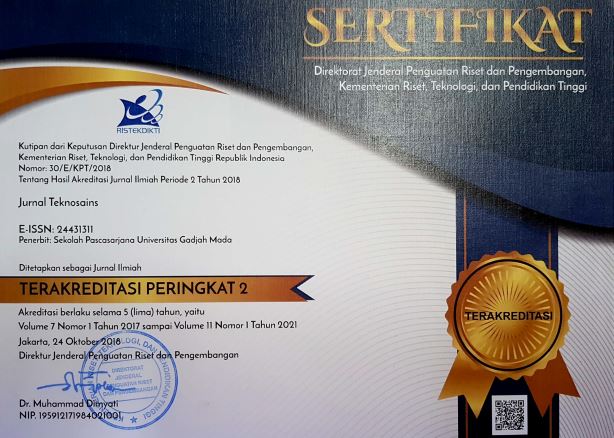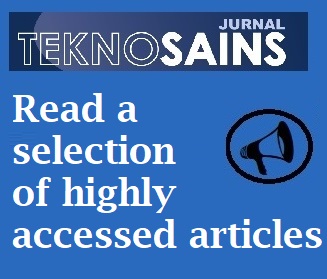Optimasi unjuk kerja pada sistem pendinginan adsorpsi dengan siklus pemanasan-ulang kombinasi
I Gusti Agung Bagus Wirajati(1*), Putu Wijaya Sunu(2), Ida Ayu Gede Bintang Madrini(3), Ni Kadek Muliati(4)
(1) Politeknik Negeri Bali
(2) Politeknik Negeri Bali
(3) Universitas Udayana
(4) Politeknik Negeri Bali
(*) Corresponding Author
Abstract
The adsorption refrigeration system is a cooling system that offers several benefits, including being environmentally friendly due to the very small amount of global warming effect given, the lack of potential for ozone depletion, the low energy consumption of its operation, the low heat source used in its operation and good for reducing gas emissions on earth. This paper describes a combined reheating adsorption refrigeration system with three heat exchangers, as well as operating modes. The operation of the adsorption refrigeration system with combined reheating is schematically described with operational modes and diagrams. This adsorption cooling system is made up of three heat exchangers (H), one evaporator, and one condenser. The combination cycle is intended for heat exchanger systems that operate in a reheat cycle (H1 and H2) and a non-reheating cycle (H3). This paper also discusses system cycle time optimization. Research to get the optimum value of cycle time in this system is still rarely done and therefore optimization of cycle time is carried out on the system to get the best performance. The PSO (particle swarm optimization) program is paired with the MATLAB program to simulate the performance of the system under discussion while also enhancing its performance. The goal of this work is to use simulation to determine the optimal system performance versus the overall cycle time, which includes adsorption/desorption time, pre-cooling and pre-heating time as well as mass recovery time. Getting the best value for the entire cycle time is made possible by fusing the simulation of the system's process performance with performance optimization. As a results, the greatest increase in the optimization results' performance value occurs at a heat source temperature of 55ºC with a longer time to achieve optimal performance.
Keywords
Full Text:
PDFReferences
Akahira, A., Alam, K. C. A., Hamamoto, Y., Akisawa, A., & Kashiwagi, T. (2004). Mass recovery adsorption refrigeration cycle—improving cooling capacity. International Journal of Refrigeration, 27(3), 225–234. https://doi.org/10.1016/J.IJREFRIG.2003.10.004
Alam, K. C. A., Hamamoto, Y., Akisawa, A., Kashiwagi, T. (2003). Advanced adsorption chiller driven by low temperature heat source. 21st International Congress of Refrigeration, 17–22.
Alam, K. C. A., Khan, M. Z. I., Uyun, A. S., Hamamoto, Y., Akisawa, A., & Kashiwagi, T. (2007). Experimental study of a low temperature heat driven re-heat two-stage adsorption chiller. Applied Thermal Engineering, 27(10), 1686–1692. https://doi.org/10.1016/J.APPLTHERMALENG.2006.07.006
Ally, M. R., & Sharma, V. (2018). Variability of absorption heat pump efficiency for domestic water heating and space heating based on time-weighted bin analysis. Applied Thermal Engineering, 130, 515–527. https://doi.org/10.1016/J.APPLTHERMALENG.2017.10.142
Bahrehmand, H., & Bahrami, M. (2021). Optimized sorber bed heat and mass exchangers for sorption cooling systems. Applied Thermal Engineering, 185, 116348. https://doi.org/10.1016/J.APPLTHERMALENG.2020.116348
Boelman, E. C., Saha B.B., Kashiwagi, T. (1995). Experimantal investigation of silica gel – water adsorption refrigeration cycle – the influence of operating condition on cooling output and COP. ASHRAE Trans, 358–366.
Chua, H. T., Ng, K. C., Malek, A., Kashiwagi, T., Akisawa, A., Saha, B. B. (1999). Modeling the performance of two-bed, silica gel-water adsorption chiller. International Journal of Refrigeration, 22, 94–204.
Chua, H. T., Ng, K. C., Malek, A., Kashiwagi, T., Akisawa, A., & Saha, B. B. (2001). Multi-bed regenerative adsorption chiller — improving the utilization of waste heat and reducing the chilled water outlet temperature fluctuation. International Journal of Refrigeration, 24(2), 124–136. https://doi.org/10.1016/S0140-7007(99)00078-X
Critoph, R. E. & R. V. (1986). Possible adsorption pairs for use in solar cooling. International Journal of Ambient Energy, 7(4), 183–190.
Karagiorgas, M., & Meunier, F. (1987). The dynamics of a solid-adsorption heat pump connected with outside heat sources of finite capacity. Heat Recovery Systems and CHP, 7(3), 285–299. https://doi.org/10.1016/0890-4332(87)90141-4
Kashiwagi, K., Akisawa, A., Yoshida, Y., Alam, K.C.A., Hamamoto, Y. (2002). Heat driven sorption refrigerating and air conditioning chiller in Japan. Proc. of the International Sorption Heat Pumps Conference, 50–62.
Khan, M. Z. I., Alam, K. C. A., Saha, B. B., Akisawa, A., & Kashiwagi, T. (2007). Study on a re-heat two-stage adsorption chiller – The influence of thermal capacitance ratio, overall thermal conductance ratio and adsorbent mass on system performance. Applied Thermal Engineering, 27(10), 1677–1685. https://doi.org/10.1016/J.APPLTHERMALENG.2006.07.005
Mizanur Rahman, A. F. M., Ueda, Y., Akisawa, A., Miyazaki, T., Saha, B. B. (2013). Performance comparison of three-bed adsorption cooling system with optimal cycle time setting. Heat Transfer Engineering, 34(11–12), 1–10.
Pinheiro, J. M., Salústio, S., Rocha, J., Valente, A. A., & Silva, C. M. (2020). Adsorption heat pumps for heating applications. Renewable and Sustainable Energy Reviews, 119, 109528. https://doi.org/10.1016/J.RSER.2019.109528
Riaz, N., Sultan, M., Noor, S., Sajjad, U., Farooq, M., Khan, M. U., Hanif, S., & Riaz, F. (2022). Recent developments in adsorption heat pumps for heating applications. Advances in Mechanical Engineering, 14(4), 1–32. https://doi.org/10.1177/16878132221089444
Rogala, Z. (2017). Adsorption chiller using flat-tube adsorbers – Performance assessment and optimization. Applied Thermal Engineering, 121, 431–442. https://doi.org/10.1016/J.APPLTHERMALENG.2017.04.059
Saha, B. B., Koyama, S., Choon Ng, K., Hamamoto, Y., Akisawa, A., & Kashiwagi, T. (2006). Study on a dual-mode, multi-stage, multi-bed regenerative adsorption chiller. Renewable Energy, 31(13), 2076–2090. https://doi.org/10.1016/J.RENENE.2005.10.003
Saha, B. B., Koyama, S., Kashiwagi, T., Akisawa, A., Ng, K. C., & Chua, H. T. (2003). Waste heat driven dual-mode, multi-stage, multi-bed regenerative adsorption system. International Journal of Refrigeration, 26(7), 749–757. https://doi.org/10.1016/S0140-7007(03)00074-4
Saha, B. B., Koyama, S., Lee, J. B., Kuwahara, K., Alam, K. C. A., Hamamoto, Y., Akisawa, A., & Kashiwagi, T. (2003). Performance evaluation of a low-temperature waste heat driven multi-bed adsorption chiller. International Journal of Multiphase Flow, 29(8), 1249–1263. https://doi.org/10.1016/S0301-9322(03)00103-4
Tchernev, D.I., Emerson, D. . (1988). High efficiency regenerative zeolite heat pump. ASHRAE Trans, 50–62.
Tong, C. H., Choon, N. K., Malek, A., Kashiwagi, T., Akisawa, A., Saha, B. B. (2000). ). A regenerative adsorption process and multi reactor regenerative adsorption chiller.
Wirajati, I.G.A.B., Akisawa, A., Ueda, Y., Miyazaki, T. (2015). Experimental investigation of a reheating two-stage adsorption chiller applying fixed chilled water outlet conditions. Heat Transfer Research, 46, 293–309.
Wirajati, I.G.A.B., Ueda, Y., Akisawa, A., Miyazaki, T. (2014). The performance of three-bed re-heat combined adsorption chiller. International Sorption Heat Pumps Conference, 7.
Article Metrics
Refbacks
- There are currently no refbacks.
Copyright (c) 2022 I Gusti Agung Bagus Wirajati dkk.

This work is licensed under a Creative Commons Attribution-ShareAlike 4.0 International License.
Copyright © 2024 Jurnal Teknosains Submit an Article Tracking Your Submission
Editorial Policies Publishing System Copyright Notice Site Map Journal History Visitor Statistics Abstracting & Indexing









